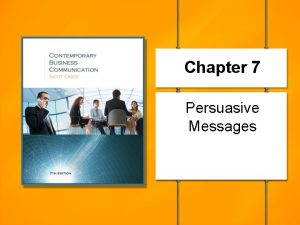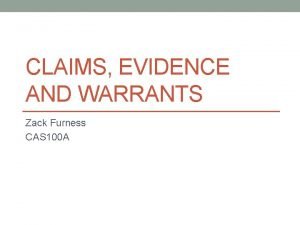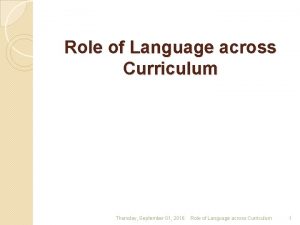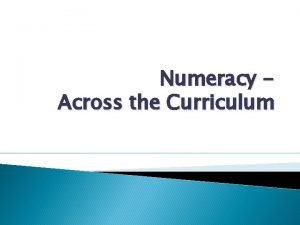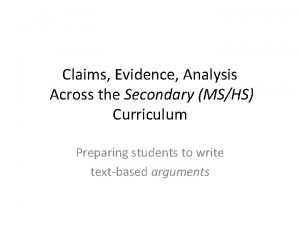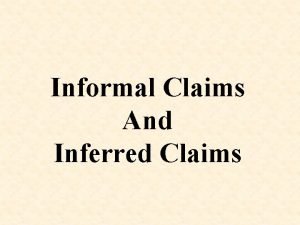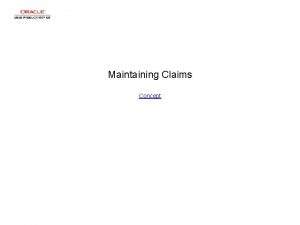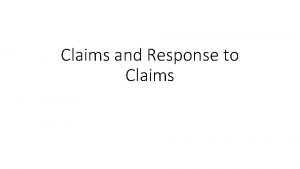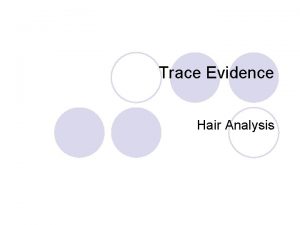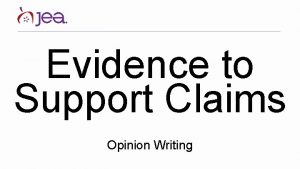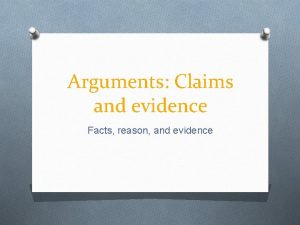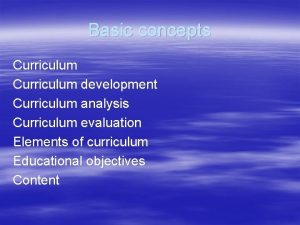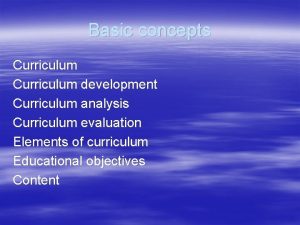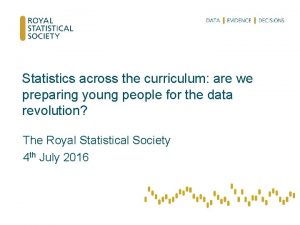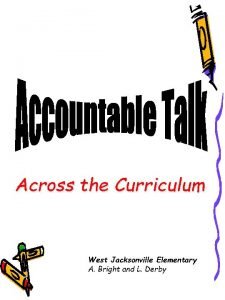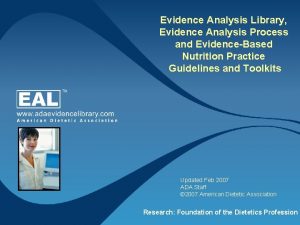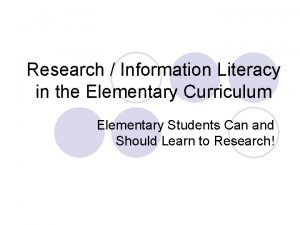Claims Evidence Analysis Across the Elementary Curriculum Preparing
























- Slides: 24

Claims, Evidence, Analysis Across the Elementary Curriculum Preparing students to write Criteria-based opinions and text-based opinions

The Power of a School-wide Focus Claims, Evidence, Analysis • The thinking that supports argumentation is new and complex; we can’t wait till we write a “portfolio-like piece” to learn how to think like an opinion writer. It needs to be part of the knowledge we BRING to the piece, not new skills that we must orchestrate while we are researching and writing about a topic. • We therefore must layer the teaching of these skills in smaller ways, through notebook entries and quick drafts, providing feedback to students that helps them master a few skills at a time rather than expecting them to integrate multiple new skills simultaneously. • Through Mini-units, we are not trying to teach THE opinion paper, but rather teach and practice discrete persuasive moves. Students may later select from several of these short drafts to develop and revise a longer opinion piece. Standards tell us what students must be able to do, but not how to do that; standards are missing the techniques that get us to claim and evidence. These mini-units provide those techniques. • We also must teach and practice making claims and using evidence in every content area, all year long, if students are to become proficient in opinion writing.

The Power of a School-wide Focus Resiliency/Stamina • In a school where writing scores have been persistently low or stagnant, resiliency research provides an effective lens through which to plan work with students and teachers. • Students and teachers must believe to achieve. – School work is hard, but we can build our stamina as readers and writers through multiple short drafts. – High standards + support is feasible in our classrooms. Formative assessment and focused feedback lifts the quality of student work.

Adapted from RESILIENCY IN SCHOOLS: MAKING IT HAPPEN FOR STUDENTS AND EDUCATORS by Nan Henderson & Mike Milstein (Corwin Press, 1996)

What Works • School-wide Focus on Claims/Evidence/Analysis. – Informal opportunities: use the language of claim/evidence to • discuss school issues; • discuss current events; • stop spontaneously as we read to make claims and identify specific pieces of evidence from the text. – Planned lessons and mini-units featuring claims/evidence/analysis. – Formative assessment as well as on-demand assessment to measure progress and provide feedback

Focus on Claims/Evidence/Analysis is Standards-Driven ELA CCSS for Writing W. 1 Write arguments to support claims in an analysis of substantive topics or texts using valid reasoning and relevant and sufficient evidence Kindergarten Use a combination of drawing, dictating, and writing to compose opinion pieces in which they tell a reader the topic or the name of the book they are writing about and state an opinion or preference about the topic or book (e. g. , My favorite book is. . . ). KWP/jb/March 2015 Grade 1 Write opinion pieces in which they introduce the topic or name the book they are writing about, state an opinion, supply a reason for the opinion, and provide some sense of closure. Grade 2 Write opinion pieces in which they introduce the topic or book they are writing about, state an opinion, supply reasons that support the opinion, use linking words (e. g. , because, and, also) to connect opinion and reasons, and provide a concluding statement or section. Grade 3 Write opinion pieces on topics or texts, supporting a point of view with reasons. a. Introduce the topic or text they are writing about, state an opinion, and create an organizational structure that lists reasons. b. Provide reasons that support the opinion. c. Use linking words and phrases (e. g. , because, therefore, since, for example) to connect opinion and reasons. d. Provide a concluding statement or section. Grade 4 Write opinion pieces on topics or texts, supporting a point of view with reasons and information. a. Introduce a topic or text clearly, state an opinion, and create an organizational structure in which related ideas are grouped to support the writer’s purpose. b. Provide reasons that are supported by facts and details. c. Link opinion and reasons using words and phrases (e. g. , for instance, in order to, in addition). d. Provide a concluding statement or section related to the opinion presented. Grade 5 Write opinion pieces on topics or texts, supporting a point of view with reasons and information. a. Introduce a topic or text clearly, state an opinion, and create an organizational structure in which ideas are logically grouped to support the writer’s purpose. b. Provide logically ordered reasons that are supported by facts and details. c. Link opinion and reasons using words, phrases, and clauses (e. g. , consequently, specifically). d. Provide a concluding statement or section related to the opinion presented.

Focus on Claims/Evidence/Analysis is Standards-Driven ELA CCSS for Informational Reading R. 1 Read closely to determine what the text says explicitly and to make logical inferences from it; cite specific textual evidence when writing or speaking to support conclusions drawn from the text. Kindergarten Grade 1 Grade 2 Grade 3 Grade 4 Grade 5 With prompting Ask and answer questions Refer to details and Quote accurately from a and support, ask questions about key such as who, what, where, to demonstrate examples in a text when explaining what and answer details n a text. when, why, and how to understanding of a text, explaining what the text says explicitly and questions about demonstrate understanding referring explicitly to the says explicitly and when drawing inferences key details in a of key details in a text as the basis for the drawing inferences from the text. answers. the text. R. 8 Delineate and evaluate the argument and specific claims in a text, including the validity of the reasoning as well as the relevance and sufficiency of the evidence. With prompting Identify the reasons an Describe how reasons Describe the logical Explain how an author and support, author gives to support specific points the connection between uses reasons and identify the points in a text. author makes in a text. particular sentences and evidence to support reasons an paragraphs in a text (e. g. , particular points in a text, author gives to comparison, cause/effect, identifying which reasons support points in first/second/third in a and evidence support a text. sequence). which point(s). R. 9 Analyze how two or more texts address similar themes or topics in order to build knowledge or to compare the approaches the authors take. With prompting Identify basic similarities Compare and contrast the Integrate information and support, in and differences most important points and from two texts on the from several texts on the identify basic between two texts o the presented by two texts on key details presented in same topic in order to similarities in same topic (e. g. , in the same topic. two texts on the same topic. write or speak about the and differences illustrations, descriptions, subject knowledgeably. between two or procedures). texts on the same topic (e. g. , in illustrations descriptions, or procedures).

Why Mini-Units? i 3 College Ready Writers Program National Writing Project The US Department of Education’s program, Investing in Innovation, funded the College-Ready Writers Program. The innovation that NWP proposed was to provide professional development to rural secondary schools in the teaching of argument. Innovation requires trying something new, taking risks, and diving in. This approach is showing promise in many schools and districts that are participating in the project. This year the Kentucky Writing Project has been adapting these materials to expand the project to elementary classrooms and to use the frameworks to develop additional mini-units on other topics and for all contents. Trying a mini-unit approach (instead of a traditional, lengthy unit) is new for many teachers and may feel risky.

What are the Mini-Units? From NWP CRWP i 3 College Ready Writers Program The mini-units are short teaching units (3 -8 class periods or less) that result in students writing opinion pieces using either criteria on which to base a judgement or by using sources as evidence. These mini-units are engaging for students. They are designed to be layered, with new mini-units being taught periodically over the course of the year. • They typically start with readings using strategies that support students in understanding an issue. • They then move quickly to support students’ opinion writing. • They don’t intend to teach students everything they need to know about writing opinions, but rather to focus a few key skills. • The design requires we use a succession of mini-units, building on the students’ work each time.

What are the Common Components? From NWP CRWP i 3 College Ready Writers Program • A progression of work in opinion writing around a common topic – – – Close viewing and reading that includes writing about the readings and videos. Focus on a particular skill or move that writers use in order to write opinion pieces. Revisiting the readings to draft an opinion. Focused feedback provided on students’ use of the skill. Students are supported in making revisions based on that feedback. Such a process layers over time the complex array of skills that students will eventually need to orchestrate in order to demonstrate competence in opinion writing. • A text set – – To connect students to issues that will invite them—even incite them—to write. Informational texts that will provide information for students as they seek to understand the topic and then later, will serve as evidence for students as they take positions on the topic. OR Opinion pieces that introduce different perspectives on the topic, allowing students to consider their own stances and then select the most compelling pieces of evidence to support and extend their own thinking. While we encourage you to first try the mini-units with these original texts—because we know these texts work with real students—reteaching the mini-unit may be helpful in developing students’ expertise. A second or third text set could be substituted at this point.

Common Components, cont. From NWP CRWP i 3 College Ready Writers Program • Close reading and exploratory writing – Strategies slow students down enough to really think about the facts, the issues, and the perspectives involved. – Guidance in identifying evidence that could be used to support a claim. – Writing to learn and to discover so that students see the complexities in taking a stand on an issue as well as have opportunities to carefully consider their own stances. • Focus on Opinion – Emphasis on at least one particular element of opinion development—a skill or writing move that helps students make effective opinions. – The intent is to work more intensely on a particular aspect of opinion writing, master it, and then take up another mini-unit that will focus on a different, but equally important move that opinion writers make. – A chart is provided that identifies some of these elements that students will be learning. – Mini-units allow teachers to layer the instruction of opinion writing so that students are learning one or two key moves in a single mini-unit that they will then be expected to take up more independently in subsequent writing opportunities. • Writing Processes – Students draft their own texts AND revise them after feedback from peers and/or teacher. • Sense-making and Transfer/ Processing – We need to name what we are learning in order to be able to access it later. Student self-assessment, peer assessment, and/or reflection are part of most mini-units.

Mini-units feature tools to support students in learning how to write opinions • Harris Moves: To help students learn to use sources effectively • Bernabei Kernel Essays: To help students learn to consider purpose as they organize their opinion pieces • Organizers and partner/small group activities to scaffold student writers as they learn new skills

Harris Moves: Ways to Use Sources t e m A r Illustrating – When writers use specific examples or facts from a text to support what they want g n to say. chi o h p a Tea ents to to T d I u D Examples: t E s R C e r “_____ argues that ______. ” v o i h g t u The 18 -wheeler carries a “_____ claims that ______” e h ______” lots of cargo, representing “_____ acknowledgestthat ● ● “material to think about: anecdotes, images, scenarios, data. ” (Harris) ● ● ● “_____ emphasizes that ______” “_____ tells the story of ______ “ “_____ reports that ______” “_____ believes that ______” Leeanne Bordelon, NSU Writing Project, 2014

Example of Illustrating a s i h t s i y a In what w ? t c a f r o e l p m a x e from “The Early Bird Gets the Bad Grade” by Nancy c i f i c e p s t h g i m m i a l c Kalish: What kind of pport? su o t d e s u e b it When high schools in Lexington changed their start times to 8: 30 a. m. , the number of teens involved in car crashes dropped. In the rest of the state, however, teen crashes increased. Linda Denstaedt, i 3 Leadership Team, National Writing Project

Harris Moves: Ways to Use Sources r t e m A r o h p a e p p u s t n i n e g d n i u n t s n Begi ntary as e Authorizing – When writers ● m e l e y d a e are r quote an expert or use the credibility or status of a source to support their claims. ds r o w What each Joseph Bauxbaum, a cancer researcher, found … make n seem perso le? ib d e r c Susan Smith, principal of a school which encourages im student cell phone use, … a l c t Wha each The Gulf Coast Center, a non-profit organization which might elp h monitors the environment, discovered that … quote rt? suppo Leeanne Bordelon, NSU Writing Project, 2014

Example of Authorizing Ann Jones, PTA president, said the best way to get parents to come to school is to have a student performance. s d r o w What her seem make le? credib t h g i m im a l c t Wha ote help u this q rt? suppo Linda Denstaedt, i 3 Leadership Team, National Writing Project

Harris Moves: Ways to Use Sources iddle r o h p a t e A m m r y o d f a e n r o i e t r a a r a s t p n e r e p ud t In s s a l o o Countering – Countering--When s●ch a writer “pushes back” by disagreeing with the text, challenging something it says, or interpreting it differently than the author does. he t e r a What ements l key e od While parent groups often see video games negatively, of a go ”? ter n u new research indicates there are positive effects. o c “ Leeanne Bordelon, NSU Writing Project, 2014

Example of Countering Acknowledge the opposition, then refute it: While many people think ____, the research actually shows… Or summarize the opposition, then give your case: ____ argues that ____. What the author doesn’t consider is … ____ says that ____. This is true, but … ____ suggests that ____. The author doesn’t explain why …. ____ argues that ____. Another way to look at this is … Leeanne Bordelon, NSU Writing Project, 2014

Bernabei’s Kernal Essay Templates First I thought… Overview of the Issue Some people think ___ because… Then I learned… Others think ___ because… Now I think… The most compelling evidence is ____; it has made me think… In the end, I say…

Organizers Connecting Evidence to a Claim: Opinion Planner Claim: _________________________________ Source: Title, author, publication, website URL, date, page numbers, etc. Evidence from the article (fact, statistic, quote, etc. ) _______________ The text says… Connection: Possible Outcome or Result: How could you connect the evidence to your purpose? How can you help readers see the RELEVANCE or importance of this fact to the context or situation? How and why does this evidence support your claim? Give examples. What might happen if we use this evidence to make a decision about how we’ll think, act, or believe? Here’s how it applies to my claim: If we do this…

What Might a Year Look Like? August September Baseline On. Analysis of First Demand & Analysis mini-unit drafts of work Writing into the Day activities to introduce Thinking Like an Opinion Writer --------Initial Mini-Unit Focus on Making a Claim /feedback/revision October November-December Analysis of Second mini-unit drafts Analysis of 3 rd mini-unit drafts Selection & teaching Review of drafts from nd teaching of 2 mini of 3 rd mini-unit first 3 mini-units. -unit Focus on Explaining Selection of one to Focus on Evidence the Evidence develop further (i. e. , add Selection /feedback/revision more evidence and /feedback/revision explanation), receive feedback, then revise, edit, and publish. Example: Bluegrass Example: Exercise Awards and the Brain Example: What Should We Eat

What Might a Year Look Like? January February Mid-Year On. Analysis of Fourth Demand analysis mini-unit drafts of work March-April-May Analysis of Independent Opinion drafts End-of-Year Assessments (class and/or state) Selection & teaching of Planning, Researching, Revision study based 4 th mini-unit and Drafting an on needs and Independent Opinion completion of final Focus/feedback/re. Piece drafts vision on logical development and Focus on research On-demand practice structure skills (finding credible and prep with bellsources) and ringers and lessons orchestrating all around student work opinion writing skills samples learned to date Example: Sugary Drinks

Using Mini-Units in PD From NWP CRWP i 3 College Ready Writers Program Things to look for you read and write your way through a mini-unit: – Ways a lesson supports students’ engagement with and access to texts and topics; – How the unit builds enough knowledge to write a short opinion by recursive reading and writing. Post-demonstration questions for debriefing: – How does the design of this lesson support students in trying new ways of thinking? How do these experiences support students in writing opinions? How often should such a lesson be repeated to develop processes that become habits? – How close is what you just did as a learner/reader/writer to what your students are currently doing in opinion writing? What will get them ready to do this work? What kinds of things will you consider in adapting these materials for your students and your classroom? – What are the key components of this mini-unit? Where should this unit be positioned in a year of learning? How do we use this framework to design and plan OTHER writing experiences with different materials or topics? – What are the challenges and opportunities in teaching this mini-unit? What shifts will you need to make to do this work? What kinds of support might you/your fellow teachers need as you take up or adapt the miniunit’s lessons and materials?

Fall Emphasis: Tie Instruction to Needs • Analyzing Student Work. This sets the course for classroom lessons. You’ll want to do an on-demand baseline to see what students can do before initiating mini-unit instruction. Sample questions for analysis: • • • How many students understand the difference between fact and opinion? How many can make a claim? (state an opinion, not repeat a fact) How many can give a reason to support a claim? How many use criteria to support a claim? How many use evidence from a text to support a claim? How many organize effectively (intro, body, conclusion; transitions)? How many use multiple pieces of evidence? How many use a variety of kinds of evidence? How many connect the evidence to the claim (explain)? • Selecting and Adapting Mini-Units to address students’ needs
 Effective persuasive claim letters
Effective persuasive claim letters Zack furness
Zack furness Role of language across curriculum
Role of language across curriculum Numeracy across the curriculum audit
Numeracy across the curriculum audit Preparing data for analysis
Preparing data for analysis Primary evidence vs secondary evidence
Primary evidence vs secondary evidence Primary evidence vs secondary evidence
Primary evidence vs secondary evidence Secondary sources
Secondary sources Primary evidence vs secondary evidence
Primary evidence vs secondary evidence Jobs vancouver
Jobs vancouver Fiber evidence can have probative value.
Fiber evidence can have probative value. Class vs individual evidence
Class vs individual evidence Difference between physical and testimonial evidence
Difference between physical and testimonial evidence A pair of latex gloves was found at a crime scene
A pair of latex gloves was found at a crime scene Example of fallacy
Example of fallacy Cca
Cca Hình ảnh bộ gõ cơ thể búng tay
Hình ảnh bộ gõ cơ thể búng tay Slidetodoc
Slidetodoc Bổ thể
Bổ thể Tỉ lệ cơ thể trẻ em
Tỉ lệ cơ thể trẻ em Gấu đi như thế nào
Gấu đi như thế nào Chụp phim tư thế worms-breton
Chụp phim tư thế worms-breton Chúa yêu trần thế
Chúa yêu trần thế Môn thể thao bắt đầu bằng chữ đua
Môn thể thao bắt đầu bằng chữ đua Thế nào là hệ số cao nhất
Thế nào là hệ số cao nhất
